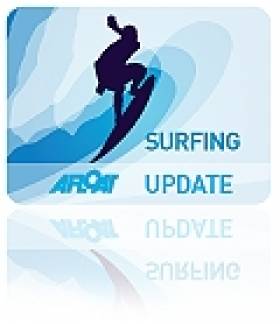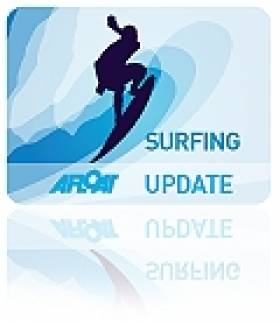Displaying items by tag: Speed Sailing
Sailrocket Speed Sailing Records Confirmed
#SPEED - The World Speed Sailing Records Council has confirmed two new world records set by Paul Larsen's Vestas Sailrocket 2 last month.
As previously reported on Afloat.ie, the Weymouth-based sailor and his crew claimed an average speed over over 59 knots with a peak of 63.5 knots on the 500-metre run on Namibia's Skeleton Coast using the purposely designed hydrofoil.
Their speed smashes the previous record of 55.65 knots set by kitesurfer Rob Douglas in the 2010 Luderitz Speed Challenge.
But not content to rest on their laurels, two days later they did it again - raising the bar for the fastest nautical mile along the same stretch of coastline by more than 5 knots, and taking the accolade held by Alain Thébault's Hydroptère since 2009.
For Larsen, the confirmation is vindication for more than a decade spent chasing 'the perfect reach'.
Over 60kts! Now... Let's See What SailRocket 2 Can Really Do!
Two days after finally smashing the Outright world speed sailing record, the Vestas Sailrocket 2 team decide to tackle the 'Nautical Mile' world record which was held by the mighty 'Hydroptere'. It was always going to be an interesting challenge for the VSR2 team as the speed course that they sail on in Walvis Bay, Namibia is defined by a beach which is exactly 1.04 miles long. This requires them to launch the boat out in more exposed waters and try and get up to as high a speed as they dare in rough water before they hit the start of the mile. At the end of the course they also fire out into rough water and have to bring the boat to a stop. It's hard on the boat. The beach is not straight but has a slight curve in it .
The mile is measured by TRIMBLE GPS equipment in a straight line so pilot Paul Larsen needs to balance between sailing in close to the beach for the flat water... and sailing the straightest and hence shortest distance between A and B. In this run, with winds that averaged just under 25 knots, The team smashed not only the nautical mile record* by over 5 knots averaging over 55.3 knots... but also raised their own 'Outright speed' record* to 59.38 knots over 500 meters hitting a peak speed of 64.78 knots (74.55 mph, 120 kph).
For Larsen it was the perfect payback for 10 years chasing 'the perfect reach'. Speed sailing had paid him back in full and a dream was realised.
VSR2 performed exactly as predicted by the Sailrocket design team of Malcolm Barnsley and Chris Hornzee Jones at AEROTROPE. The spec for the boat was to be able to hit 65 knots in 26 knots of wind in order to average around 60 knots.
From the Vestas Sailrocket 2 team in Namibia on Saturday:
Well the big forecast is playing out. It's 1017 here and the wind is already in. Our little corner of the Walvis Bay Yacht Club is buzzing as we prepare for the big day that we know lies ahead.
This is the first big wind day we have had in over 6 weeks now.
Today we focus purely on taking the outright record over 60 knots.
The project has been going on a big up for some time now and we want it to continue that way. Things can easily go the other way. The day is going to pump. We used to try and use that power to punch through our glass ceilings but now we have shown that we don't need it. We are operating at around 2.4-2.5 times windspeed and a few more knots makes a big difference. The thing is that whilst we know we will have a lot more power if it's gusting up to 30... what we don't know is what the nature of our drag curve is up ahead. Is it gradual or is it another 'brick wall'. On paper we expect cavitation to happen just over 65 knots. That's on paper. How it manifests itself is yet to be seen.
This boat is damned powerful and in 30 knots, sheeted in hard with around 65-70 knots of apparent wind it's going to be one hell of a tug of war between the wing and the foil. VSR2 is being optimised for a big number. The pitch of the main foil has been reduced by 0.25 degrees, fairings have been added to the front of the stub beam (which holds the foil) and the outboard flap that controls the height of the leeward float has had its negative pitch range increased to help me keep it all on the level.
Later that day: Fresh off the TRIMBLE... 68.01 over 1 second, 65.45 over 500 meters.
And on Sunday: On the GT-31 gps 67.74 and an average 500m 65.37! Yihaaaaaaaaaa...
(Records subject to WSSRC Ratification)
sailrocket.com
Sailrocket 'Smashes' World Speed Sailing Record
#SPEED RECORD - Weymouth-based sailor Paul Larsen and his crew have laid claim to a new world record in speed sailing, as BBC News reports.
The team say they achieved an average speed of over 59 knots - with a peak of 63.5 knots - on a half-kilometer run at Namibia's Skeleton Coast using their purposely designed Vestas Sailrocket 2.
Their speed "smashed" the previous record of 55.65 knots set by kitesurfer Rob Douglas in the 2010 Luderitz Speed Challenge, although it is yet to be confirmed by the World Speed Sailing Records Council.
It was the culmination of 10 years' hard work on the part of Australian-born Larsen and his team, using the specially adapted design built on the Isle of Wight - a vessel that's "very impractical in conventional sailing terms", as Larsen told the Times.
He added: "We are buzzing — no-one has done this with a sailing boat before... This shows how unique and revolutionary the boat is.
"We’ve had to break the boundaries of sailing — like the equivalent of our sound barrier — just over 50 knots."
The boat's designer Chris Hornzee-Jones said the vessel - inspired by the success of speed sailing kitesurfers and windsurfers like Oisín can Gelderen - was key to their breakthrough.
"It is designed to be an ideal testing platform for trialling new foil concepts which will allow us to break through this 'glass ceiling' and perform at speeds well over 60 knots.”
Van Gelderen Claims Irish Speed Sailing Title for 2011
#WINDSURFING - Oisín van Gelderen is all but confirmed as Irish Speed Sailing Champion for the second year running.
His national record speed (44.23 knots by 5x10 second average and 43.96 knots over 500m) puts him far ahead of his nearest competition in the rankings.
But his competitive spirit would not let him rest on his laurels.
"Ever since setting that record in February, I have been trying to beat it," he said, "and we had a really good day on Thursday in Dungarvan."
Though he did not beat his averages, he did set a new Irish record for peak speed at 47.89 knots (verification pending).
Van Gelderen dedicated his previous national title win to to the memory of Surfdock founder Alan Harris and Irish 500m speed record holder John Kenny, who both passed away in 2010.
Meanwhile, his Surfdock teammate Noelle Doran has taken the women's title for 2011 with a very impressive set of times for the year.
Her Irish women's peak record of 38.17 knots was complemented by third overall place for 2011 by 5x10 second average and first in the world over 500m.
"I'm so delighted for her," said Van Gelderen. "She had a nasty injury a few years ago, where she dislocated her hip while windsurfing. The resulting nerve damage put a stop to her competing in Waves and Freestyle, where she had multiple national titles."
Who is the Fastest of 'em All: Kite v Moth v 49er?
For most involved in conventional stick and cloth boating, the 49er dinghy is the ultimate speed machine. Its description as 'the high performance class' at the Olympic regatta gives it that ultimate status. Before you watch the vid below tho, ask yourself what's fastest: Moth, kiteboard or 49er.....choose carefully before clicking play on this (strong language) video!
Oisín van Gelderen Takes Speed Sailing Title
Oisín van Gelderen has won the Irish Speed Sailing Championship for 2010 after a phenomenal season.
The Afloat.ie/Irish Independent Sailor of the Month for September 2010 had a clean slate of results for the year, posting the fastest speeds over 500m and by 10-second average.
But the highlight of his year was undoubtedly his personal record-breaking speed trials in West Kirby, near Liverpool (SEE VIDEO BELOW) where he reached a maximum speed of 47.17 knots (87.36 kmph).
"I am looking forward to 2011, and hope to improve my speeds, and spend a lot more time back in the waves this year too," he said.
Van Gelderen dedicated his title win to the memory of Surfdock founder Alan Harris and Irish 500m speed record holder John Kenny, who both passed away in 2010.
Dublin Windsurfer Claims Irish Speed Sailing Record
"I know for sure my Max Speed of 47.17 knots is the fastest any Irish sailor has ever done" he claims.
The current record, approved by the World Speed Sailing Council, was set by John Kenny in February who achieved a personal best of a burst of 45.3 knots (it's 84 kph) and averaged 42.52 for the 500 metres.
Van Gelderen describes the build up to yesterday's record attempt at the UK's West Kirby venue:
"The wind was pretty strong - 30-40 knots, so I rigged my brand new Pryde 4.7m RSRacing - just to get the hang things. As it turned out, this sail was perfect for me all day (I'm not the heaviest speed-sailor at 78 kgs).
I knew my board was already fast, but I'm also delighted with the sail, which was rigged for the first time and performed straight away without any tuning.
Van Gelderen's record breaking tracks are HERE

Oisin Van Gelderen concentrates on a speed sailing record run in West Kirby yesterday, its famous wall in the background





























